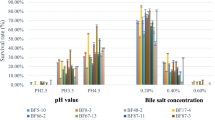Abstract
The “cocktail” of human origin rifampicin-resistant bifidobacteria (RRBs) and RRBs from commercial products was administrated to 9 volunteers aged from 22 to 46 years and the survival ability in gastrointestinal tract of these strains was determined. Bifidobacteria represented 0–8 % of total anaerobes detected in gastrointestinal tract of volunteers before the administration of probiotic strains. After the administration of probiotics, bifidobacterial counts increased to 16 % of total bacterial counts. RRBs formed 9–44 % of total counts of bifidobacteria. Then, the counts of RRBs decreased at day 7 after administration, and they were not detected after 14 d. In our study, suitable probiotic bifidobacterial strains for human should be chosen on the basic of in vitro test but the results showed that no strain was able to colonize human tract permanently.
Similar content being viewed by others
References
Benno Y., Mitsouka T.: Impact of Bifidobacterium longum on human fecal microflora. Microbiol.Immunol.36, 683–694 (1992).
Bezkorovainy A.: Probiotics: determinants of survival and growth in the gut. Am.J.Clin.Nutr.2, 399–405 (2001).
Bouhnik Y., Pochart P., Marteau P., Arlet G., Godere I., Rambaud J.C.: Fecal recovery in humans of viable Bifidobacterium sp. ingested in fermented milk. Gastroenterology 102, 875–878 (1992).
Brigidi P., Vitali B., Swennen E., Altomare L., Rossi M., Matteuzzi D.: Specific detection of Bifidobacterium strains in a pharmaceutical probiotic product and in human feces by PCR. Syst.Appl.Microbiol.3, 391–399 (2000).
Collins J.K., Thoron G., O’sullivan G.: Selection of probiotic strains for human applications. Internat.Dairy J.8, 487–490 (1998).
Fujiwara S., Seto Y., Kimura A., Hashiba H.: Intestinal transit of an orally administered streptomycin-rifampicin-resistant variant of Bifidobacterium longum SBT2928: its long-term survival and effect on the intestinal microflora and metabolism. J.Appl. Microbiol.90, 43–52 (2001).
Fuller R.: Probiotics in human medicine. Gut32, 439–442 (1991).
Kailasapathy K., Chin J.: Survival and therapeutic potential of probiotic organisms with reference to Lactobacillus acidophilus and Bifidobacterium spp. Immunol.Cell.Biol.78, 80–88 (2000).
Kopečný J., Mrázek J., Fliegerová K., Frühauf P., Tučková L.: The intestinal microflora of childhood patients with indicated celiac disease. Folia Microbiol.53, 214–216 (2008).
Křížová J., Španová A., Rittich B.: RAPD and rep-PCR fingerprinting for characterization of Bifidobacterium species. Folia Microbiol.53, 99–104 (2008).
Kullen M. J., Amman M.M., O’shaughnessy W., O’sullivan D.J., Busta F.F., Brady U.: Differentiation of ingested bifidobacteria by DNA fingerprinting demonstrates the survival of an unmodified strain in the gastrointestinal tract of humans. J.Nutr.127, 89–94 (1997).
Langhendries J.P., Detry J., Van Hees J., Lamboray J.M., Darimont J., Mozin M.J., Secretin M.C., Senterre J.: Effects of a fermented infant formula containing viable bifidobacteria on the fecal flora composition and pH of healthy full-term infants. J.Pediatr.Gastroenterol.Nutr.21, 177–181 (1995).
Matsuki T., Watanabe K., Tanaka R., Fukuda M., Oyaizu H.: Distribution of bifidobacterial species in human intestinal microflora examined with 16S rRNA-gene-targeted species-specific primers. Appl.Environ.Microbiol.65, 4506–4512 (1999).
Palacios M.C., Haros M., Rosell C.M., Sanz Y.: Selection of phytate-degrading human bifidobacteria and application in whole wheat dough fermentation. Food Microbiol.25, 169–176 (2008).
Pochart P., Marteau P., Bouhnik Y., Godere I., Bourlioux P., Rambaund J.C.: Survival of bifidobacteria ingested via fermented milk during their passage through the human small intestine: an in vivo study using intestinal perfusion. Am.J.Clin.Nutr.55, 78–80 (1992).
Rada V., Petr J.: A new selective medium for the isolation of glucose non-fermenting bifidobacteria from hen caeca. J.Microbiol. Meth.43, 127–132 (2000).
Saarela M., Hallamaa K., Mattila-Sandholm T., Mättö J.: The effect of lactose derivatives lactulose, lactitol and lactobionic acid on the functional and technological properties of potentially probiotic Lactobacillus strains. Internat.Dairy J.13, 291–302 (2003).
Salminen S., Lahtinen S., Gueirnonde M.: Probiotics and the reduction in risk of disease. Austral.J.Dairy Technol.60, 99–103 (2005).
Stanton C., Gardiner G., Lynch P.B., Collins J.K., Fitzgerald G., Ross R.P.: Probiotic cheese. Internat.Dairy J.8, 491–496 (1998).
Tannock G.W.: Normal Microflora. An Introduction to Microbes Inhabiting the Human Body. Chapman and Hall, London 1995.
Vlková E., Rada V., Šmehilová M., Killer J.: Auto-aggregation and co-aggregation ability in bifidobacteria and clostridia. Folia Microbiol.53, 263–269 (2008).
Wang R., Cao W.W., Cerniglia C.E.: PCR detection and quantitation of predominant anaerobic bacteria in human and animal fecal samples. Appl.Environ.Microbiol.62, 1242–1247 (1996).
Yuki N., Watanabe K., Mike A., Tagami Y., Tanaka R., Ohwaki M., Morotomi M.: Survival of a probiotic, Lactobacillus casei strain Shirota, in the gastrointestinal tract: selective isolation from feces and identification using monoclonal antibodies. Internat.J.Food Microbiol.48, 51–57 (1999).
Author information
Authors and Affiliations
Corresponding author
Rights and permissions
About this article
Cite this article
Grmanová, M., Vlková, E., Rada, V. et al. Survival of bifidobacteria in adult intestinal tract. Folia Microbiol 55, 281–285 (2010). https://doi.org/10.1007/s12223-010-0042-5
Received:
Revised:
Published:
Issue Date:
DOI: https://doi.org/10.1007/s12223-010-0042-5



